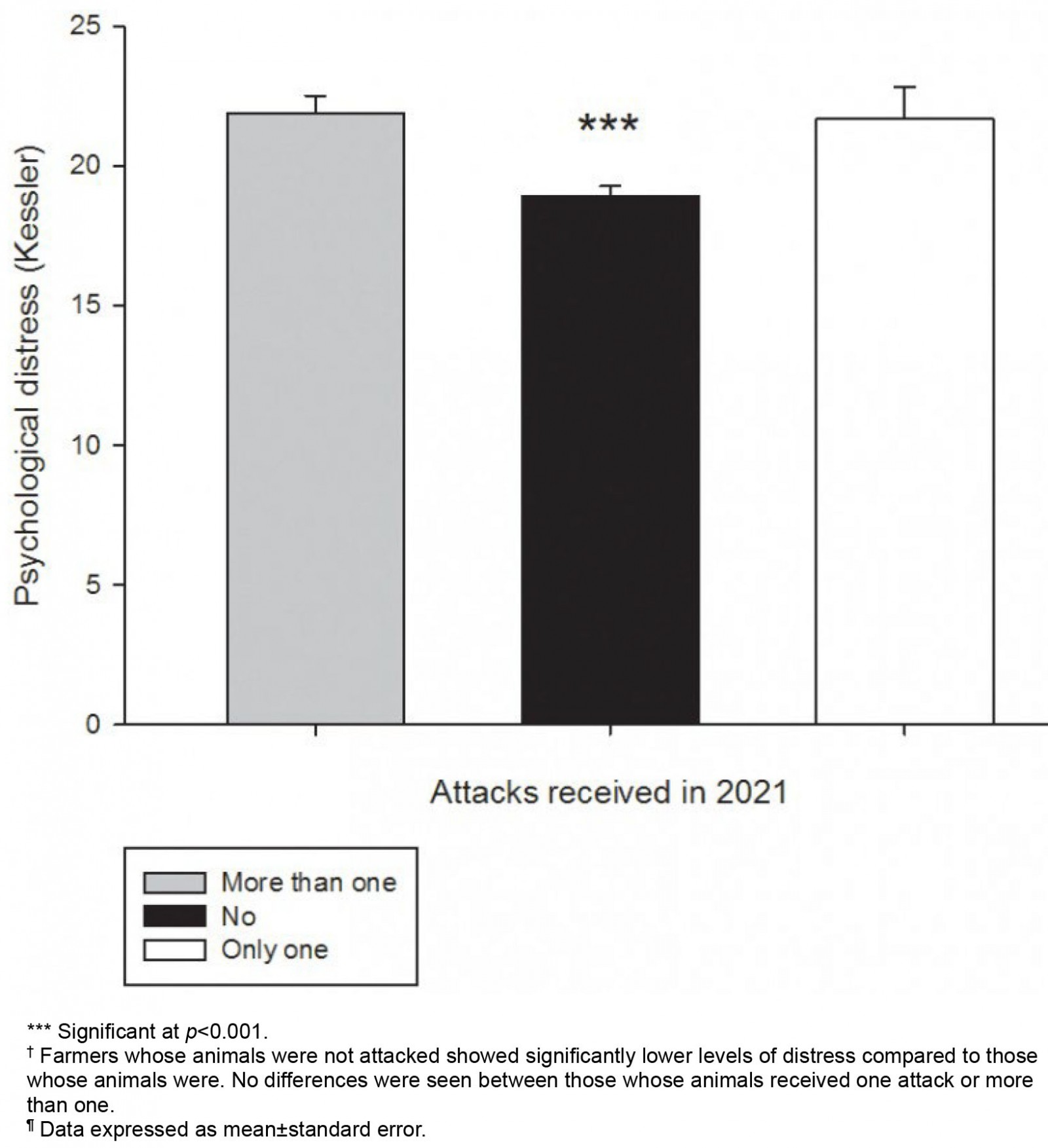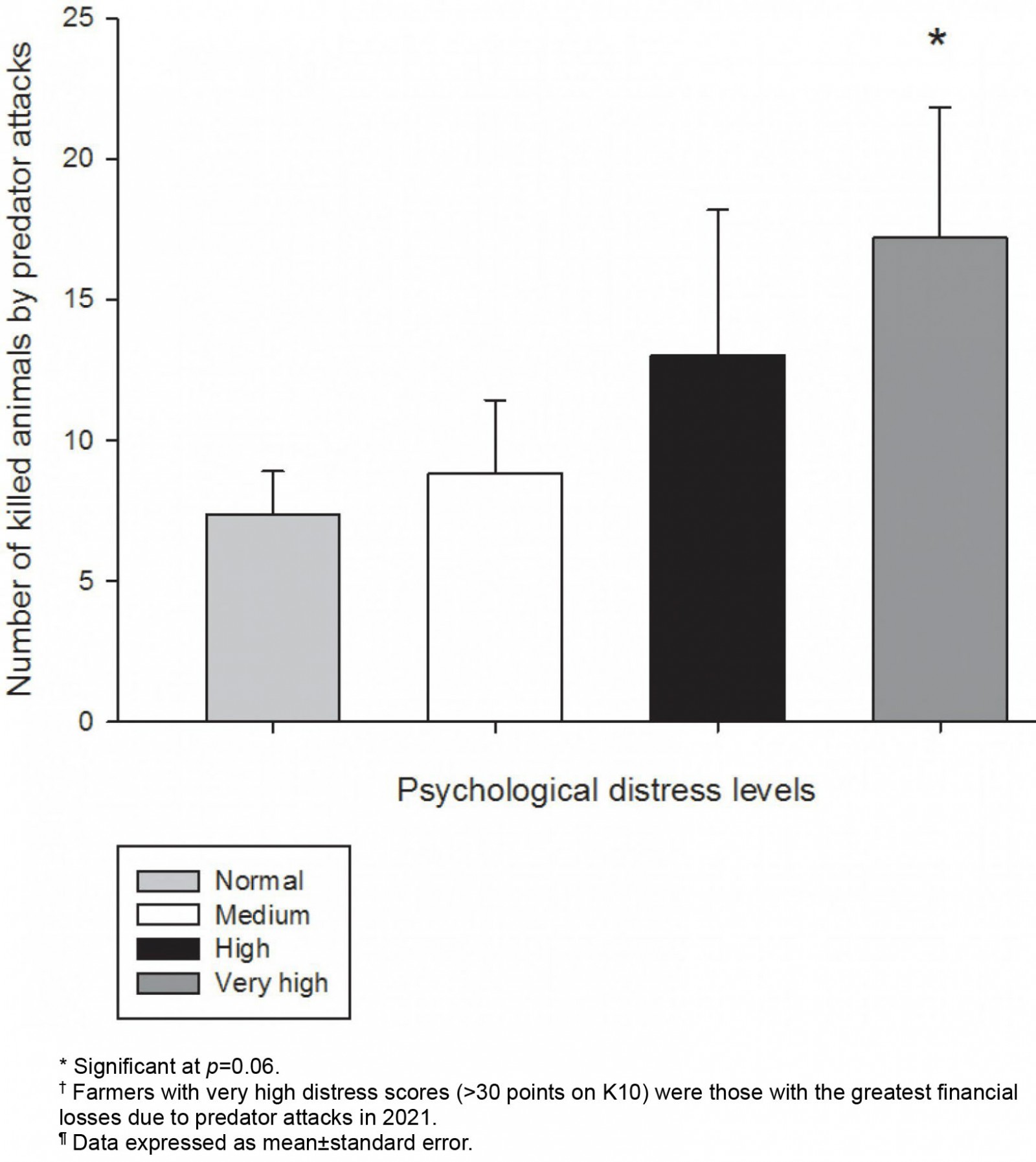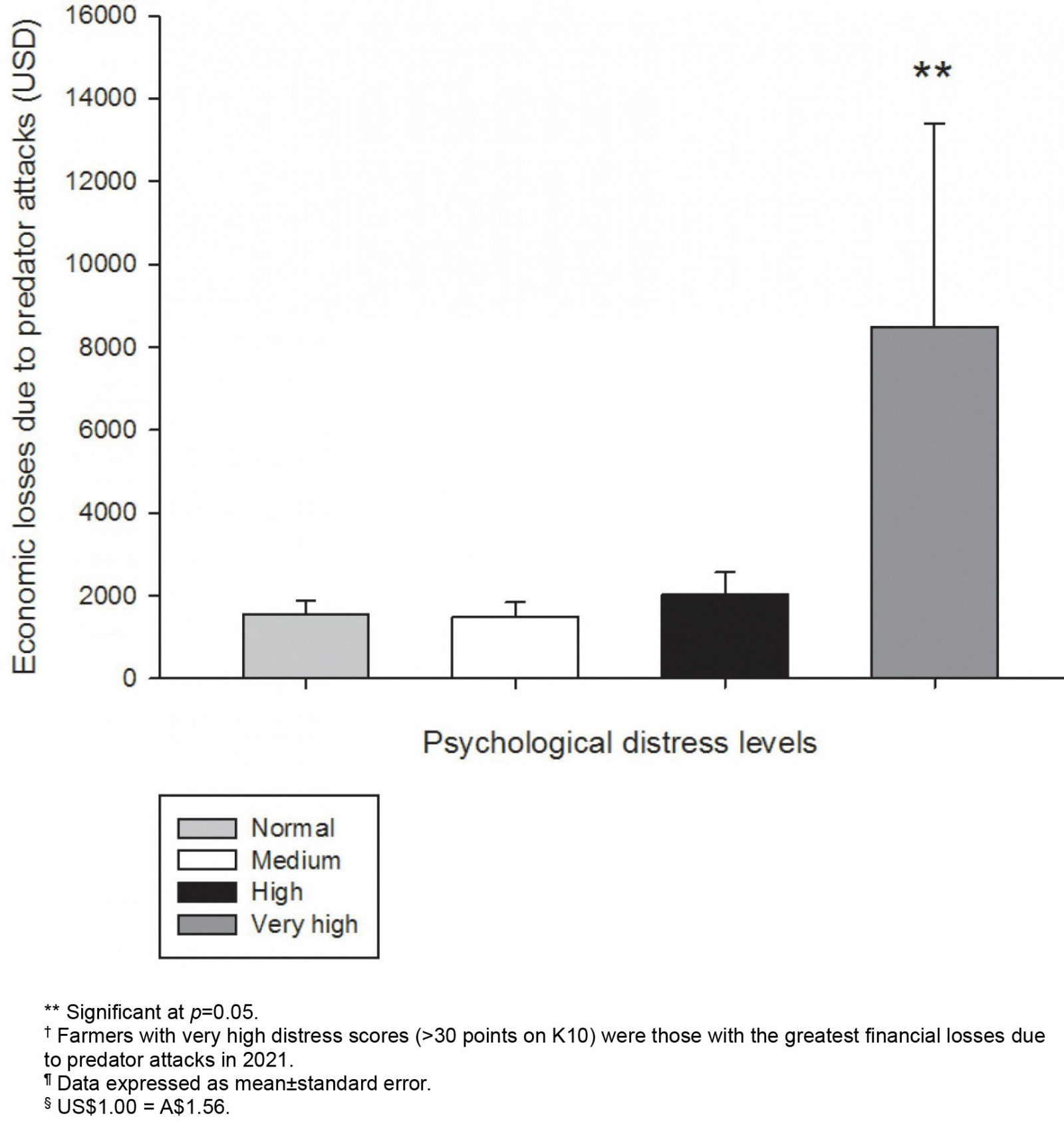Introduction
Livestock production systems play a key role in rural life, because they provide employment and income to families, which is particularly relevant in developing countries1. Due to the immense growth in the human population, livestock production systems, as a source of food, have also increased remarkably in recent years2. The growth of livestock production systems requires extensive use of natural resources, such as land and water, and the clearing of native vegetation3. In addition, livestock production systems, through the emission of greenhouse gases, contributes to global warming4. All these characteristics bring about changes in ecosystems, in which the productive systems compete with wild species for natural resources5. In this context, it is important to highlight the broad concept of One Health, which refers to the interconnections of human, animal and environmental health6. Wild species can interact with productive species and farmers, either generating attacks or transmitting diseases, and having a negative impact on health and wellbeing; conversely, agriculture and farms represent a great threat of extinction to wild animals, especially in developing countries7. In this sense, achieving an adequate balance between productive species (livestock) and wild systems is a difficult human challenge8.
Uruguay is a small South American country (3.47 million people), with an important livestock industry (more than 11 million cattle and more than 7 million sheep). The 2011 Uruguayan general rural census9 recorded 44 781 farms, occupying 16 357 298 ha and generating 7% of gross domestic product10. The main sources of livestock production are cattle (45.73%), sheep (24.63%), poultry (19.57%) and pigs (10.06%). The country is characterized by production systems based on pastures, and with a great commitment to green and clean production. However, in these production systems (often extensive) the productive animals are susceptible to attack by predators. In recent years, farmers have communicated the injuries that their animals receive and the number of deaths cause by predators (mainly dogs, but also foxes and other animals). The attack of predators on productive animals generates great concern for animal welfare and is a clear example of the One Health concept, given the high number of animals that get injured, suffer and die11. In addition, the injuries and deaths of animals lead to great financial losses for farmers; in many cases the animals are their only source of income.
Little is known about how predator attacks on productive animals impact the psychological (mental) health of farmers. In this study we set out to evaluate psychological distress of farmers through the Kessler Psychological Distress Scale (K10).
The concept of psychological distress is associated with depressive and anxious symptoms12. It is understood as symptoms of anxiety and depression expressed in the previous month on the K1013. The K10 was developed by Ronald Kessler and Dan Mroczek in 1992 to measure non-specific psychological distress, and was revised in 199414. The K10 takes into account a variety of symptoms related to anxiety and depression, and the score is related to the suffering of psychological distress (but without specifying a disorder)12. Psychological distress is a set of emotional and behavioral reactions that may or may not evolve into different psychopathological conditions. Although the distress does not respond to a specific picture of mental pathology, it maintains a high comorbidity with other more serious disorders15. This scale consists of 10 questions that assess symptoms of depression and anxiety in a Likert-scale format, and it has been tested in several Latin American countries such as Ecuador14, Argentina12, Peru15 and Uruguay16. In Uruguay, psychological distress has been measured on few occasions. Alcohol consumption, like suicide and depression, have been related to psychological distress in young Uruguayans16-19. During the COVID-19 pandemic, psychological distress measured by the K10 could be associated with greater drug use in both the first wave of cases (2020) and the second (2021)20,21.
The objective of this study was to determine if predator attacks on productive species during 2021 influenced the psychological distress of farmers. A second objective was to evaluate whether the psychological distress of farmers varied according to the financial losses generated by predator attacks on their farms. For an exploratory stage we developed a cross-sectional survey.
Methods
Sample and procedures
Different instruments, described in depth in the next section, were compiled in a virtual questionnaire developed with the proprietary Google Forms software. The invitation, which contained a link to the survey, including the informed consent form, was disseminated electronically between November and December 2021, achieving participation of 442 farmers from all 19 departments of the country (74.3% men, average age 52.1±13.3 years). The sampling frame included all rural workers in the country. The survey was sent electronically to the different institutions linked to rural work, especially the Rural Federation of Uruguay, whose organization helped disseminate the survey to all workers in the country. For each variable, all cases were reviewed for inconsistencies, repetition of answers or answers meeting some of the exclusion criteria (Table 1).
Table 1: Animal losses and psychological distress of farmers according to number of predator attacks in Uruguay, 2021
Instruments and variables
The K10 was used with a five-point Likert-type response format, with scores range between 10 and 50 points (with higher scores indicating higher levels of psychological distress). The K10 evaluates the risk of presenting unspecific psychological distress (symptoms of anxiety or depression) in the previous month. The score can be divided into four levels of psychological distress: normal (<20 points), medium (20–24 points), high (25–29 points), and very high (≥30 points)13. The K10 is appropriate because it has been used in Uruguay, which makes comparison of results possible, and it is a short, quick-response scale. Others that have applied this scale in Uruguay have determined an adequate reliability (Cronbach’s alpha) of 0.8516,20; in the present study it is 0.84.
Demographic data
Questions related to age, sex, department of residence and about predator attacks on animals were applied. Questions were asked about the number of attacks in 2021, the number of injured and dead animals, and estimated financial losses due to these attacks.
Data analysis
First, a descriptive analysis of psychological distress was performed for the sample. Simple associations between variables related to distress such as age or the number of predator attacks were analyzed using Pearson’s correlation coefficient.
The total scores of the K10 were analyzed through independent ANOVAs that were considered as comparison factors between groups having had predator attacks or not. This model was also used to compare the number of dead animals and financial losses between levels of psychological distress.
To study which variables had the greatest predictive capacity for psychological distress, multiple linear regressions were performed considering the number of attacks, financial losses in US dollars, and number of dead and injured animals.
The type I error (alpha) was set (for all analyses) at 0.05. The p-values between 0.05 and 0.1 were considered as a tendency to significance. All analyses were performed in Statistica v7.0 (Spotfire; https://www.spotfire.com/products/data-science).
Ethics approval
This study was designed and conducted in adherence to the indications of the Declaration of Helsinki. Privacy and data confidentiality were maintained throughout the process.
Results
Descriptive analysis of psychological distress
The mean distress score measured by the K10 was 20.4±7.2. Considering the ranges according to the scores, 53.6% were normal, 24.6% medium, 11.3% high and 10.2% very high.
Correlational analysis
A trend of a negative correlation between age and psychological distress was found, with youngest farmers tending to have higher distress scores (r=–0.08, p=0.1).
There was a significant and positive correlation between the number of animals killed in 2021 attacks and distress scores (r=0.24, p=0.01), as well as between financial losses generated by attacks and psychological distress scores (r=0.35, p<0.01).
No correlations were found between distress scores and number of predator attacks received in 2021, nor between the distress scores and the number of animals injured in the attacks.
Bivariate analysis
Regarding predator attacks, based on the ANOVAs, it was shown that those whose animals were not attacked in 2021 had lower distress scores than those whose animals had one or more than one attack (F(2, 447)=9.54, η2p=0.04, p<0.001) (Fig1).
People expressed very high levels of psychological distress tended to have more animal deaths (F(3, 107)=2.45, η2p=0.06, p=0.06) (Fig2), and they were the ones who lost the most money due to attacks (F(3, 97)=2.55, η2p=0.07, p=0.05) (Fig3).
 Figure 1: Psychological distress scores (K10) in farmers in Uruguay, 2021. †¶
Figure 1: Psychological distress scores (K10) in farmers in Uruguay, 2021. †¶
 Figure 2: ANOVAs between psychological distress scores (K10) and number of animals killed by predator attacks in Uruguay, 2021. †¶
Figure 2: ANOVAs between psychological distress scores (K10) and number of animals killed by predator attacks in Uruguay, 2021. †¶
 Figure 3: ANOVAs between psychological distress scores (K10) and losses from predator attacks (US$) in Uruguay, 2021.†¶§
Figure 3: ANOVAs between psychological distress scores (K10) and losses from predator attacks (US$) in Uruguay, 2021.†¶§
Multivariate analysis
Multiple linear regression (R2=0.33) showed that the variables that best explain the variation in psychological distress are the number of attacks in 2021 (β=0.345, p<0.05) and the estimated financial losses from the attacks (β=0.384, p<0.05).
Discussion
In this study, it was determined that the psychological distress of farmers was negatively influenced by predator attacks on their productive animals. The psychological distress of farmers was more evident with greater numbers of animals killed by predators and greater financial costs. Therefore, the situation experienced by many farmers in Uruguay due to attacks by predators on their farms significantly affects their psychological health and wellbeing. To our knowledge, this is the first work carried out in Latin America that reports psychological distress of farmers influenced by predator attacks on their productive animals.
Our results coincide with other studies carried out in other regions of the world. For example, in Bhutan it was reported that farmers suffer different mental health disorders (mental distress, constant worries about food insecurity, fears for physical safety, frustration with movement restriction) due to wild predators attacking livestock and crops, affecting their psychological health and wellbeing22. In Australia, Ecker et al23 reported that the attack of dogs on farm livestock generates psychological disturbances in farmers, such as lack of sleep, anger and frustration; and impacts on relationships at personal, business and community levels. Similar results have been reported in Norway, where sheep farmers in areas inhabited by wolves experience higher levels of psychological distress24. Furthermore, as reported by studies in Nepal25 and in India26, livestock predation by carnivores is costly for farmers. Therefore, the financial loss of herds due to predators can seriously affect the wellbeing of farmers, being able to destroy in many cases the only wealth of rural families in developing countries27. Given the results of these studies and the present study, the need to seek public policies that can address these situations is raised.
We have previously studied psychological distress in different populations in Uruguay using the same scale. Comparing the results of this work with previous ones, it is noteworthy that the K10 distress score for farmers (20.4 points) is not the highest. When we applied this scale to a sample of young people aged between 18 and 30 years in Uruguay, the average was 24.8 points16, and when we applied it in the first year of the COVID-19 pandemic in Uruguay, the average was 21.7 points20, and in the second year of the pandemic it was 25.1 points21. This shows that the subpopulation in the present study is not the most affected in terms of mental health compared to other subpopulations in Uruguay.
Continuing with the comparison of these measurements with those of other studies carried out with this variable in Uruguay, it is consistent that there are higher levels of distress in younger people. Similar results have been seen in other studies carried out in the country, where people aged less than 30 years showed significantly higher levels of distress20. Moreover, in our study no differences were found between the sexes in distress scores, unlike other previous studies in the country16,20,21. Most of the people who carried out the survey were men, which could have influenced and limited the finding of differences. Future work, with a larger number of participants, is needed to corroborate these results.
The most interesting finding is the relationship between psychological distress scores and having received predator attacks on farms. Farmers who never received attacks had lower levels of distress, and those with very high distress (>30 points on the K10) are the ones who have had more animal deaths and more financial losses due to attacks. No differences in the level of distress between those who had one attack and more than one suggests that, with just one attack by predators, psychological wellbeing can be affected, without having a cumulative effect. It is also very important to highlight that the sample obtained in this work is not random, so the results should be interpreted with caution.
Conclusion
Farmers who received attacks from predators on their farms, which results in financial losses and deaths of productive animals, reported a greater negative impact on their mental health compared to those who did not receive attacks. According to these results, it would be important to attend to the financial demands and mental health services in producers affected by predator attacks.
Despite this effect, compared to other populations in the country where psychological distress has been measured, the rural population is not the most affected in this regard.
References
You might also be interested in:
2014 - Healthcare use and prescription of opioids in rural residents with pain
2011 - Attitudes of GPs towards Older Adults Psychology Services in the Scottish Highlands


